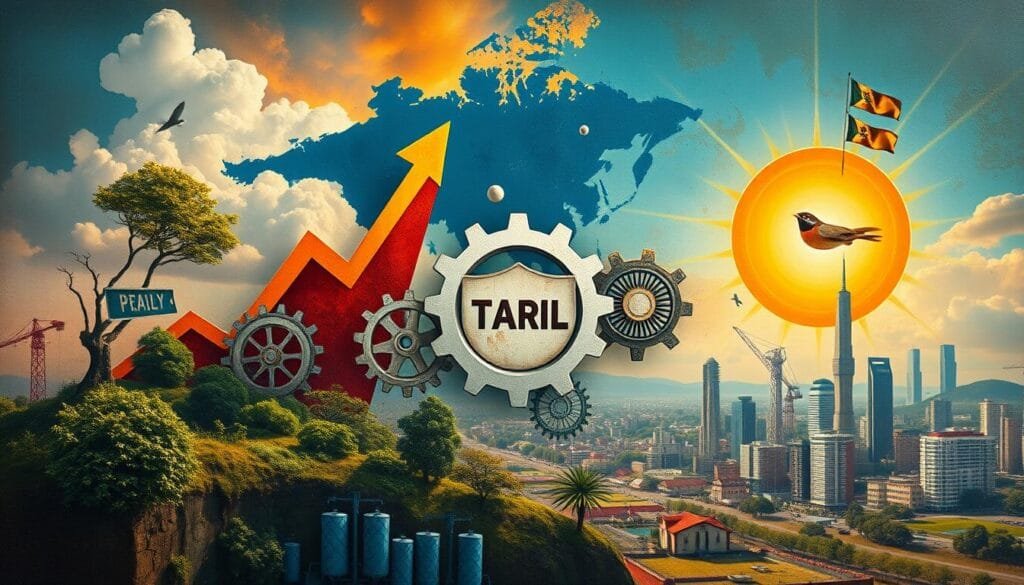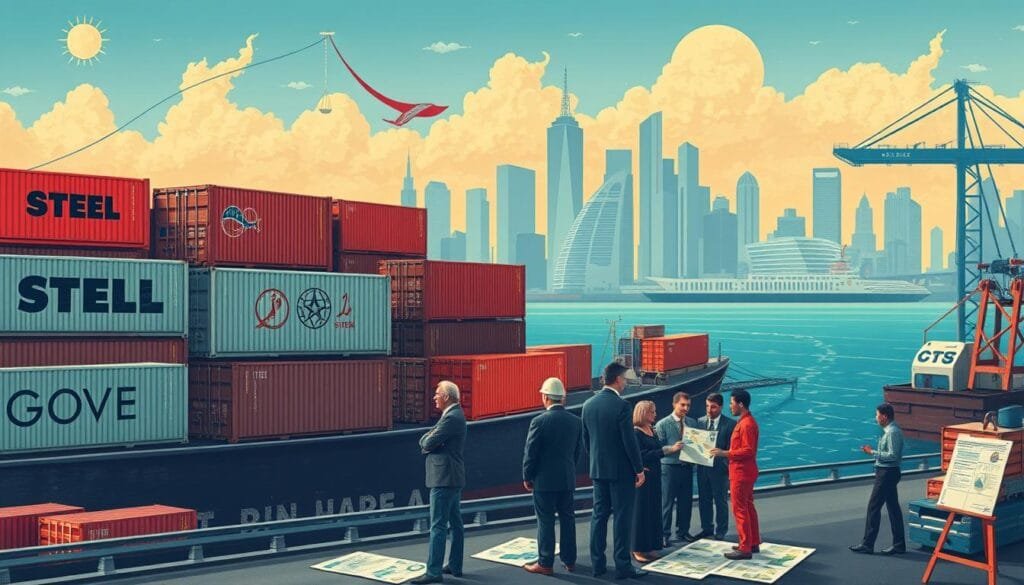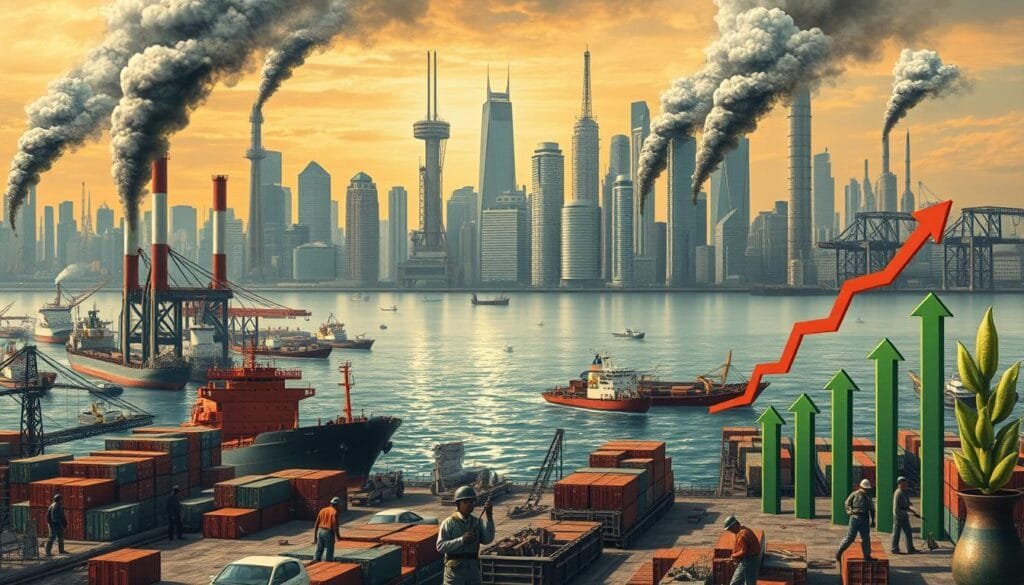We’re on a journey to understand economic growth and how tariffs play a role. Tariffs are taxes on imports that once blocked much trade. They helped American industries grow by funding and protecting them. Now, their role in the economy has changed.
Though not as crucial for government money as before, tariffs still protect against unfair trade. Before, tariffs were key for government revenue. Now, income tax has taken over. Yet, using tariffs wisely shows they still matter for defending trade.
Looking at our nation’s finances, tariffs still matter despite bringing in just $80 billion last year. This was only 2% of the Federal tax revenue. With $3.12 trillion in goods imported in FY2023, tariffs could bring in a lot of money. But, their overall impact is complex.
They might lead to higher prices and affect jobs and industries. Understanding their effect is not straightforward.
Key Takeaways
- Tariffs once played a fundamental role in the United States’ revenue, but now contribute a fraction compared to income and payroll taxes.
- The strategic use of tariffs remains relevant for economic policy, particularly for shielding domestic industries and ensuring fair trade practices.
- An increase in tariffs could have significant inflationary effects, impacting the cost of living for consumers, particularly those with lower incomes.
- While tariffs can bolster certain sectors by providing temporary protection, they may also distort economic incentives and undermine competitiveness over time.
- The use of tariffs must be balanced with the impact on the domestic economy and with consideration of global trade relations.
The Historical Role of Tariffs in Economic Development
Throughout U.S. history, tariffs have been key in shaping government budgets and trade. At first, these tariffs were the main income source for the young government. They helped fund public works.
Early U.S. Dependence on Tariffs for Revenue
In its early days, the U.S. government depended on tariffs for funds. These taxes on imports supported finances and acted as trade policy. They shielded new industries from overseas competition. This system was crucial before income or sales taxes were options.
The Shift from Tariffs to Income Tax
As the U.S. economy grew, the tax system evolved. The start of income tax in 1913 marked a big shift from tariffs. This change was due to the need for fair taxes that wouldn’t harm economic growth. Over time, income taxes replaced tariffs in funding the government. This showed the U.S. economy’s growth and global integration.
| Year | Revenue from Tariffs (in billion $) | Total Government Revenue (in billion $) | Percentage of Total Revenue |
|---|---|---|---|
| 1800 | 0.01 | 0.01 | 100% |
| 1900 | 0.23 | 0.56 | 41% |
| 2000 | 0.28 | 2.03 | 14% |
Tariffs once were crucial for U.S. funding. But as income tax came in, their role in revenue dropped. This shift changed U.S. economic and trade policies significantly.
Understanding Tariffs: Definitions and Mechanisms
To truly grasp how tariffs work, we must first know their types and purposes. Ad valorem tariffs are based on the value of the goods. This is different from specific tariffs, which charge a fixed fee by quantity, like per kilogram.
Tariffs play several roles in trade legislation. They protect young industries and help generate government revenue. In the past, tariffs were a major income source for governments. For example, in 1900, U.S. government revenue from tariffs was over 41%. By 2013, this number fell to just 2%.
Types of Tariffs and Their Purposes
It’s important to understand the types of tariffs and why they are used. Besides ad valorem tariffs, there are specific tariffs and tariff-rate quotas. They help protect local industries, balance trade deficits, or respond to unfair foreign trade practices.
The Process of Implementing Tariffs and Their Immediate Effects
The process to implement tariffs usually involves government branches. In the U.S., Congress can levy taxes and tariffs. But, the President can act on matters of national security. For example, in 2018, the U.S. raised tariffs from 2.6% to 17% on many products.
The effects of tariffs can vary. Consumers may find imported goods cost more. Some domestic industries gain from less competition, while others face higher costs. These actions can strain trade relations. In 2018, retaliatory tariffs from China and the EU affected about $121 billion of U.S. exports.
Tariffs are key economic tools for domestic protection and adjustment. Yet, their impact can spread, affecting international trade and economic wellbeing. Therefore, using tariffs wisely and balancing protectionist strategies are vital for sustainable growth.
How Does a Tariff Help with Economic Growth
Tariffs are key in helping an economy grow. They protect local businesses and cut down on imports. By focusing on domestic production protection, local industries have a chance to thrive. This helps keep a healthy trade balance. Despite the debate, when used correctly, tariffs can boost manufacturing and jobs.
But, it’s important to look at both sides. Considering tariffs’ effects on the U.S. economy involves historical data and future predictions:
| Year/Policy | Projected GDP Impact | Analysis |
|---|---|---|
| 2018 Trump Tariffs | -0.5% to -3.61% | Varied impact from different economic analysts highlighting significant contraction in GDP over several years. |
| 2002 Bush Steel Tariffs | Job losses in steel-using industries | Led to greater job losses than jobs saved within the industry, negatively affecting the economy. |
| 2009 Obama Tire Tariffs | Approx. $1.1 billion additional cost to consumers | Increased retail prices and significant job losses in the retail sector. |
| 1964 Chicken Tax | Long-term protection to U.S. truck manufacturers | Proved beneficial for U.S. heavy truck industry, protecting it for over 50 years and aiding in the success of the Ford F-150. |
The story of tariffs and the economy is complex. Tariffs are meant to guard local jobs but can raise prices. They can also lead to job losses in areas relying on imports. So, while they support domestic production protection, the overall economic effects show there’s a trade-off.

If tariffs are too harsh or not used right, they can backfire. This can cause trade wars, hurting the trade balance they sought to protect. It shows the tough job policymakers have in using tariffs to foster growth without causing global economic issues.
Modern Usage of Tariffs: Case Studies from the Trump and Biden Administrations
In the last few years, the importance of tariffs in international trade and economic strategy has grown. Both the Trump and Biden administrations have used tariffs with big impacts on America’s economy and trade ties.
The Trump Administration’s Tariff Strategy
The Trump administration changed U.S. trade policy, especially towards China. To fight unfair trade and protect American ideas, Trump era tariffs rose from below 5% to over 20% by January 2020. This led to a trade war, with China setting its own tariffs. In 2018 and 2019, these policies added nearly $80 billion in new taxes for Americans, affecting $380 billion in products.
The Biden Administration’s Continuation and Expansion of Tariffs
Under Biden, the tariff policy continued and grew from what Trump had started. Even with some changes in economic policy, the Biden team kept many Trump tariffs and added more on $18 billion of Chinese goods. This move added another $3.6 billion in taxes. The use of Biden administration tariffs raises questions about protecting local industries versus global trade health.
Here’s a closer look at how these tariffs impacted the U.S. economy:
| Indicator | Trump Administration | Biden Administration |
|---|---|---|
| New Taxes Imposed | $80 billion | $3.6 billion (additional) |
| Tariff Rate on Chinese Goods | Over 20% by 2020 | Maintained at similar levels |
| Estimated Job Impact | Loss of 142,000 jobs | Potential continuation of job impacts |
| GDP Impact | Decrease by 0.3% (2019) | Long-run decrease by 0.2% |
In conclusion, while tariffs aim to fix trade imbalances and protect local industries, the outcomes can be complex. The costs might outweigh the benefits. These policies have affected trade, consumers, and businesses in the U.S.

The Impact of Tariffs on the Domestic Economy
Tariffs are taxes on goods coming from other countries. They change how much things cost here. From what we buy to how much factories make, tariffs impact it all.
Inflationary Pressures and the Cost to Consumers
Let’s talk about how tariffs make things pricier for us. Imagine a tariff adds $100 to the cost of a $1,000 laptop. This extra cost usually ends up being paid by shoppers like us. Prices go up not just for laptops, but many things. This makes living more expensive for families. The Peterson Institute for International Economics says this doesn’t just hurt our wallets. It also makes life tougher for those already struggling.
Effects on Domestic Manufacturers and Employment
Tariffs can help our factories compete by keeping out cheaper goods from abroad. This might help them sell more for a while. But, it’s not simple. Making things can get more expensive if the parts we need also cost more due to tariffs. If factories spend more money, they might have to let workers go. Jobs might grow in some places but disappear in others.
Different businesses will react in their own ways to tariffs. They might change how they invest their money because of these new trade rules.

| Sector | Effect of Tariffs | Change in Employment |
|---|---|---|
| Automotive | Rise in material costs | Possible layoffs |
| Technology | Increased product prices | Job growth in U.S. manufacturing |
| Consumer Goods | Higher retail prices | Reduced sales impacting jobs |
In the end, while tariffs are meant to help our industries, their real effect is mixed. They can make life more costly for us, change how much is made, and shake up jobs in many ways. We’ve got to think this through to make our economy work well for everyone.
Global Reaction and the Ripple Effects of U.S. Tariffs
When the U.S. sets tariffs, it often starts a chain of actions that shake up global trade. This can affect international business. Such trade fights lead to retaliatory tariffs from other countries. This causes trade wars that hurt global supply chains and trade relationships.
The dance of tariffs and counter-tariffs changes how nations export goods. It also changes the global trade scene. Countries not directly involved, like Vietnam and Mexico, can benefit. During the US-China trade war, these countries increased their exports. But the success varies based on each country’s strategy and economic strength.
Retaliatory Tariffs and Trade Wars
The reply to U.S. tariffs usually involves matching tariffs from other countries. This leads to a back-and-forth that can grow into trade wars. The U.S. and China experienced this, affecting trade patterns globally. It shows how interconnected and sensitive global trade is.
Impact on Global Supply Chains and International Trade Relations
The effects of U.S. tariffs reach far. They force supply chains and trade strategies to change worldwide. For instance, during the trade war, countries like Mexico and Thailand stepped up. They produced more of what China used to export to the U.S. This shows how flexible international trade can be in responding to global shifts.
The overall result of these trade changes is complex. It’s not just about less trade between two combatants. Often, other countries boost their exports. This increases trade in new areas. Trade policies meant to protect may lead to big changes in how the world trades.
Equity Concerns: Who Bears the Burden of Tariffs?
Looking into tariffs reveals growing worries about economic inequality and tariff burden. We are focusing on how these economic changes touch different income groups. It’s also about finding ways to help those at risk of financial hardship.
The Distributional Impact of Tariffs on Different Income Groups
The policies on tariffs have transformed the American economy. An example is the effect of tariffs in recent years, which showed big differences in how much each income group has to bear. Lower-income families felt the impact harder than richer ones, pointing out a significant income disparity. Here’s a look at how after-tax income changed by December 2018:
| Income Percentile | Change in After-Tax Income |
|---|---|
| Lowest Quintile (0% to 20%) | -1.37% |
| Second Quintile (20% to 40%) | -1.32% |
| Middle Quintile (40% to 60%) | -1.37% |
| Fourth Quintile (60% to 80%) | -1.31% |
| Top Quintile (80% to 100%) | -1.14% |
Offsetting Measures to Mitigate Adverse Effects on Low-Income Households
To tackle these unfair impacts, new fiscal policies have been put forward. They aim to lessen economic inequality worsened by tariffs. These strategies offer financial aid to those hit hardest by the tariff burden. They use tax breaks or subsidies to help even out the economic field.
In reviewing these steps, we aim to build an economic policy that’s fairer. It’s vital to make sure that tariffs include plans to help everyone. This is especially important for people with lower incomes.
Conclusion
Our study on the tariff debate shows tariffs protect domestic industries and tackle unfair trade. But, they can also cause economic challenges. While they’ve helped sectors like steel, they’ve been linked to a drop in output growth. After implementing higher tariffs, countries saw a 0.4% fall in output growth over five years. This highlights the need for caution when using tariffs.
Trade policy outcomes show mixed results. In the U.S., the steel industry’s median earnings jumped by 52.5% from 2017 to 2022, creating thousands of jobs. Yet, tariffs also bring risks like higher prices and economic downsides.
The global steel tariffs in 2018 boosted industry jobs, showing that strong trade policies can help against international competition. However, higher costs from tariffs can lead to inflation, reducing people’s buying power. Advanced economies like the U.S. have lower average tariffs than poorer countries. This suggests they use tariffs more strategically.
When thinking about tariffs for economic growth, it’s vital to keep a balance. Policymakers need to consider the big picture of our globally linked economies. Tariffs have been key tools and continue to shape trade. But, their use must be careful and aimed at fair, future-focused economic policies.
FAQ
How do tariffs contribute to economic growth?
Tariffs encourage buying domestic goods, helping local businesses. They can reduce trade deficits. But, they may increase prices and cause trade tensions, affecting economic growth.
What was the historical role of tariffs in the U.S. economy?
Tariffs were once the main income source for the U.S. government, protecting young industries. As the country adopted a progressive income tax, tariffs became less important for revenue.
What types of tariffs are there and what are their purposes?
Tariffs like ad valorem, specific tariffs, and tariff-rate quotas exist. They aim to raise government funds, shield domestic jobs, and fix unfair trade practices.
What are the immediate effects of implementing tariffs?
Tariffs change how people shop, trade ties, and local business competition. They can spark inflation, trade fights, and force companies to rethink import and export plans.
What was the tariff strategy during the Trump administration?
The Trump administration raised tariffs to combat China’s unfair trade and protect U.S. technology. This action increased trade tensions.
How has the Biden administration approached tariffs?
The Biden administration kept Trump’s tariffs on China and added more due to unfair competition and security worries. This keeps trade policy debates alive.
How do tariffs impact domestic manufacturers and employment?
Tariffs make materials pricier for U.S. makers, possibly hurting jobs and manufacturing. High costs could lead to more unemployment and wider income gaps.
What are the global ripple effects of U.S. tariffs?
U.S. tariffs can trigger trade battles, changing global trade and politics. Exports, global supply chains, and worldwide trade relationships may suffer, reshaping diplomacy.
Who bears the burden of tariffs?
Poorer people feel tariffs the most, as they spend more of their money on affected items. This worsens income inequality.
Are there offsetting measures to mitigate tariffs’ adverse effects on low-income households?
To help, officials might use tax breaks or subsidies. These actions aim to shield low-income families from tariffs’ negative effects and avoid increasing inequality.
